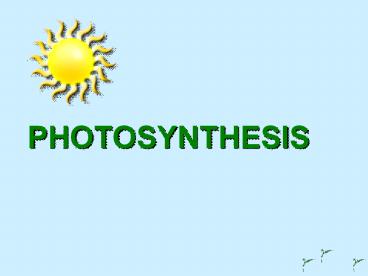PHOTOSYNTHESIS PowerPoint PPT Presentation
1 / 24
Title: PHOTOSYNTHESIS
1
PHOTOSYNTHESIS
2
Photosynthesis
- A carbon dioxide (CO2) requiring process that
uses light energy (photons) and water (H2O) to
produce (glucose). - 6CO2 6H2O ? C6H12O6 6O2
3
Question
- Where does photosynthesis take place?
4
Plants
- Autotrophs Produce their own carbohydrates.
- Photosynthetic Surface
- 1. Leaves
- a. stomate
- b. Chloroplast
5
Stomates
- Pores in a plants cuticle (outer leaf surface)
through which water and gases are exchanged
between the plant and the atmosphere.
6
Plant Cell in Leaf
7
Chloroplast
- Organelle where photosynthesis takes place.
8
(No Transcript)
9
Question
- Why are plants green?
10
Chlorophyll Molecules
- Chlorophyll pigments harvest energy (photons) by
absorbing certain wavelengths (blue-420-470 nm
and orangered-620-670 nm are most important). - Plants are green because the green wavelength is
reflected, not absorbed.
11
Wavelength of Light (nm)
12
Electromagnetic Spectrum
13
Absorption of Chlorophyll
14
Question
- During the fall, what causes the leaves to change
colors?
15
Fall Colors
- In addition to the chlorophyll pigments, there
are other pigments present. - During the fall, the green chlorophyll pigments
are greatly reduced (lower light intensity)
revealing the other pigments. - Carotenes are pigments that are orange.
- Xanthophylls are pigments that are yellow.
16
Breakdown of Photosynthesis
- Two main parts (reactions).
- 1. Light Reactions
- Converts energy from solar power (photons) into
the form of ATP and NADPH.
17
Breakdown of Photosynthesis
- Dark Reaction Calvin Cycle
- -Process of Carbon Fixation
- -Uses Carbon Dioxide from the environment and
energy (ATP and NADPH) from light rxn to make
sugar (glucose).
18
Light Reaction Summary
- Light energy excites electrons in chlorophyll
- Light energy breaks down water
- ATP and NADPH is formed
- Oxygen is released
- Occurs in the Grana
19
Electron Flow
20
Electron Flow cont.
- ADP ? ATP
- NADP 2H ?? NADPH
- Oxygen comes from the splitting of H2O, not CO2
- H2O ? 1/2 O2 2H
(Reduced)
21
Dark Rxn/Calvin Cycle
- Carbon Fixation
- Uses ATP and NADPH from light rxn.
- Uses CO2 absorbed through the stomates of the
leaves. - Produces PGAL which combines to form glucose it
takes 6 CO2 and uses 18 ATP and 12 NADPH.
22
Photosynthesis
H2O
CO2
Energy
ATP and NADPH2
Which splits water
Light is Adsorbed By Chlorophyll
Calvin Cycle
ADP NADP
Chloroplast
Used Energy is recycled.
O2
C6H12O6
Light Reaction
Dark Reaction
23
Water
Light
24
Chloroplast

